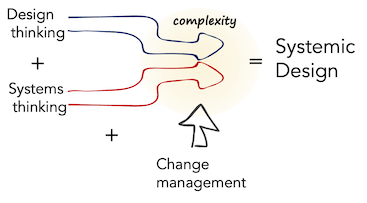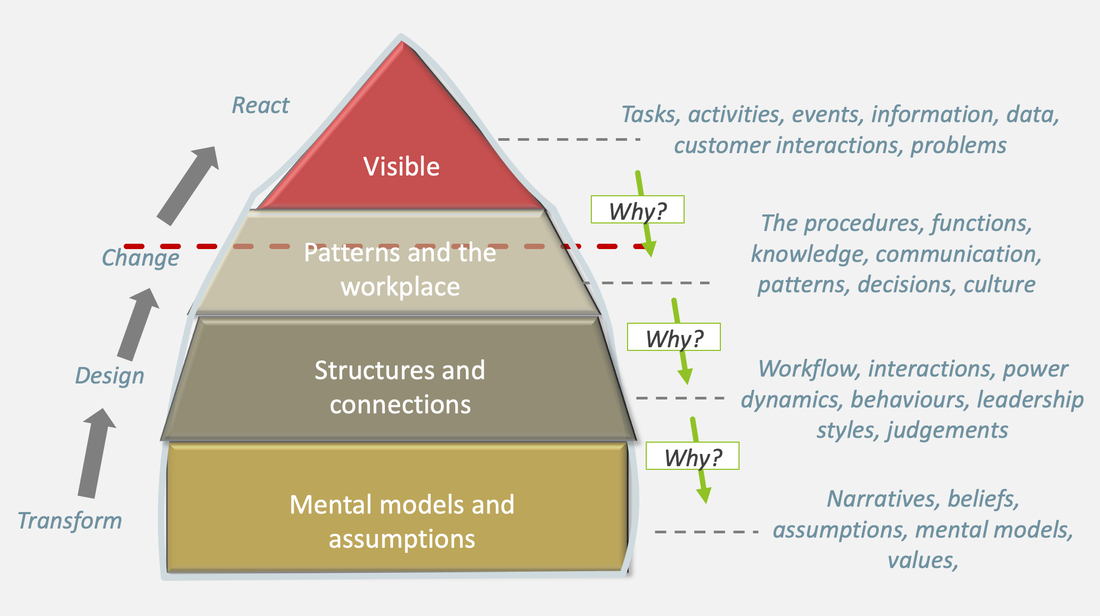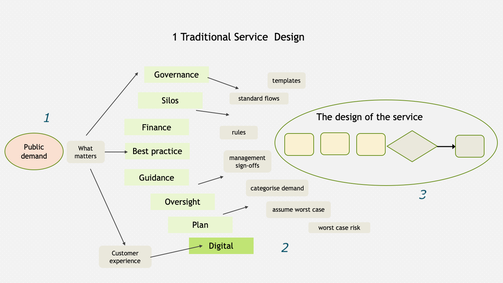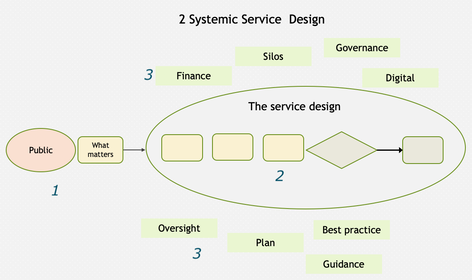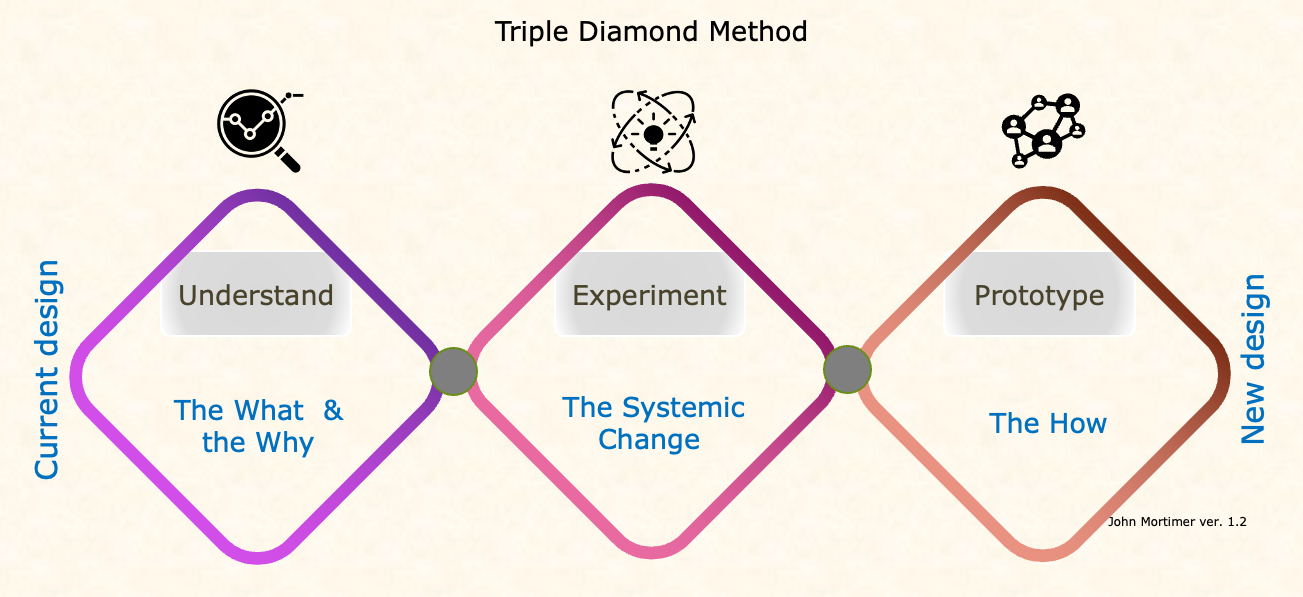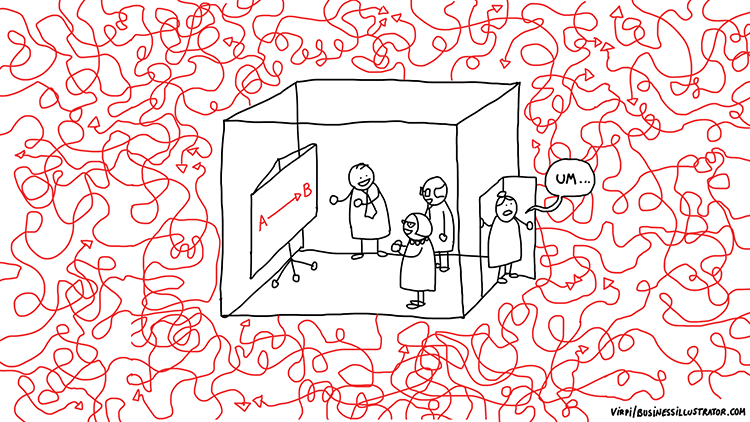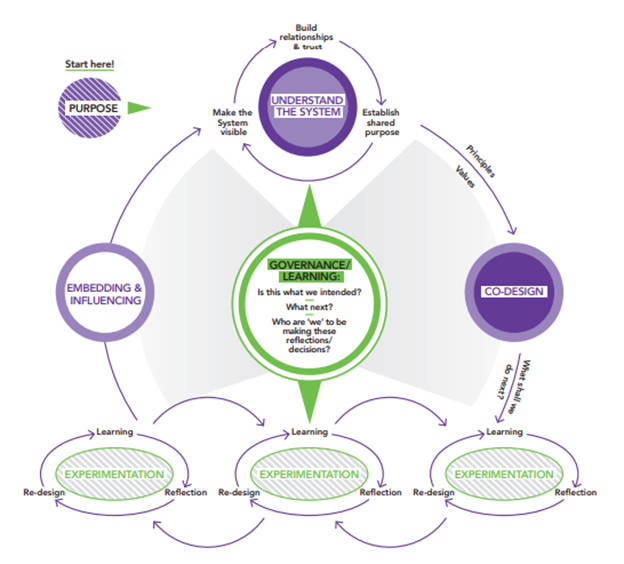|
Moving service design forwards into systemic design to incorporate systems thinking, allows us to expand the depth of how we can evolve organisations and design for complexity Service DesignMany describe basic service design as the application of digital to a design thinking approach? If we do, then we have to admit that service design is therefore bounded by digital. However, we in this article will explore service design as the design of services, using design thinking (without the constraint of digital). Systems thinkingMy definition of systems thinking for a service organisation is conceptually very simple; it is a wholistic way of looking at integrating the service, its customers, operating environment, its service delivery, and all the elements that go to making this happen. One key aspect of systems thinking that is easy to grasp, is that systems thinking sees the interactions and communication that occurs between people, departments, through the hierarchy, and with customers. It's about how people interact within an organisation, in response to customer demand. When people start to perceive their organisation through a systems lens, they gain a perspective that leads them to understand how that service can work in a fundamentally different way to traditional mechanistic & reductionist principles that operate today. There are few good paths that lead to learn about systems thinking; the best way is to practice it. And looking for how to do this can often ends up creating more confusion than it solves! I hope that this article may help to make some sense of all this. What is an organisation when viewed as a system? A system isn’t just any old collection of things. A system is an interconnected set of elements that is coherently organized in a way that achieves something. What is a systems thinking lens like?Systems thinking is a way of seeing a service, from the customers perspective, all the way through the service delivery. It understands everything that goes into that delivery, without the barriers inherent in departmental design. Therefore we can begin to redesign the service from that customer centric perspective, incorporating the staff, managers, behaviours, leadership, and the culture of that organisation.
Complexity and uncertainty are recognised as being different to transactional process design and certainty. Understanding this complexity then allows us to design in different elements to what we would have done. This then allows us to help decision-makers reframe and see their problems to sovle from a new perspective.
Service design with systems thinking = systemic designDesign thinking is based on creating something innovative. This is ideally placed to provide a vehicle for systems thinking concepts to be incorporated. Below is a diagrammatic way of demonstrating the difference between traditional service design (that begins with the needs of the organisation), and systemic service design (that starts from the customer and what matters to them.)
These are some of my systems thinking & change principles, that I use as a foundation to my design approach.
The concepts; traditional design vs systemic design. Traditional approaches reduces the problem to manageable pieces and seeks solutions to each. Practitioners of this approach believe that solving the problem piece by piece ultimately will correct the larger issue this method aims to remedy. The systemic design approach, in sharp contrast, the seeks to understand a problem situation as a system of interconnected, interdependent, and interacting issues and to create a design as a system of interconnected, interdependent, interacting, and internally consistent solution ideas. Systems designers envision the entity to be designed as a whole, as one that is designed from the synthesis of the interaction of its parts. A systems view suggests that the essential quality of a part of a system resides in its relationship with, and contribution to, the whole. Systems design requires both coordination and integration. All parts need to be designed interactively, therefore simultaneously. This requires coordination. The requirement of designing for interdependency across all systems levels invites integration. Banathy
Design thinking & systems thinkingIf systems thinking provides the perspective and how to understand it then, design thinking provides the principles, and service design is the practice. Design thinking is an iterative process in which we seek to understand the user, challenge assumptions, and redefine problems in an attempt to identify alternative strategies and solutions that might not be instantly apparent with our initial level of understanding. At the same time, design thinking provides a solution-based approach to solving problems. It is a way of thinking and working as well as a collection of hands-on methods. Design thinking is also a set of principles that defines how to design something using iterative techniques, that create emergent designs. The 'customer' is the starting point, and the inherent nature of design thinking is innovative. It is a uniquely human activity. And for the design of services, the John Seddons triple diamond model is a great place to conceptualise this: ComplexityComplexity as defined by Grint Complex problems hold a multitude of other issues within them. These problems change over time and are affected by aspects outside our control. They have no predictable solution. Complexity messes with our rationality. It pushes us to let go of that rationality as a cage and allow complexity to become normal. Understanding complexity, and therefore moving away from my prevailing and rational mindset, has helped me to understand why I often failed to sustain much of what I was trying to achieve in the past, with managing operations and people, implementing change, creating and implementing IT systems. I, like so many others, have looked back and seen the frustration and struggle to ‘get things to stick’ and how I used to blame others for that failure. Logical services - they can be analysed, and procedures created that can be applied through digital means Complex services - their interactions need to be understood, and the subsequent design is based on collaboration and fuzzy data. The presence of complexity should radically alter our approach to understanding users, and how we design services. It disrupts our view of how digital should be applied, and how we deal with knowledge and engage across the whole value chain. Understanding when to use a particular approach, helps managers to understand why sometimes their efforts are successful or futile. In both the public and private sectors, managers understanding of management concepts is rooted in mechanistic and scientific management theories. This has evolved over the past centuries through the rise of scientific thinking. However, complexity cannot be successfully dealt with by applying these traditional concepts, and attempts to do so create poor service designs, and great frustration for all working in them. There are many resources now available, at the click of a button, to help us to understand complexity and how to deal with it, so I won't go into details here. But I have found the simplicity of Keith Grint's approach to complexity a very helpful starting point. The learning of systemic design Real learning through fundamental mental shifts are difficult to achieve. This often happens whilst people are connected to the work itself. It hardly happens in a rational environment through teaching or reading. (Ref: Argyris & Schon). Systems thinking is real, and that reality is not possible to directly comprehend through human forms of communication, it should only be experienced. Its understanding lies directly in the human-ness that we are, with regard to our individual world views.
5. Human Learning Systems - A combination for systemic designThe HLS framework is an example of a methodology that can be seen combining systems thinking with design thinking. This helps us to frame the Design Council model of systems thinking into a coherent approach for change and design. Service designers systems thinking workshop...If you want to know more, then this workshop will help you as a service designer, to understand some of the systems thinking fundamental that are applicable to redesigning services.
We now delve into the background and theory of systems and design thinking. Recommended for those who wish to know more of the issues I have faced breaking boundaries of what is deemed acceptable. Getting into the background and theory - using different approachesSystems thinkers can collide because they see the world in different ways, or they can see this as essential. We should examine the different ways they see the world rather than argue about the way the world ‘actually is’. In some circumstances one viewpoint will give you the traction to bring about improvement, in others a different viewpoint is needed. You can make an informed choice of which viewpoint (and associated systems approaches) to start with but you will never really know until you are engaged in the process of using it. And you should be ready to switch as a project progresses. Best is to have a variety of viewpoints (and associated systems approaches) at your disposal. This ‘second-order’ thinking - concentrating on the nature of the systems approaches and what they can achieve, rather than pinning down what the world is like - is called critical systems thinking, perhaps most well defined by Prof Michael Jackson, OBE. It is easy to remember theory with the mind; the problem is to remember with the body. The goal is to know & do instinctively. Having the spirit to endure the training & practice is the first step on the road to understanding. Qualities required to learn about thinking things
Design thinkingBackgroundDesign thinking has always existed, but the term itself was coined in the 20th century. It became the subject of ‘papers’ and then become increasingly recognised through very practical and successful product development. An interesting and important characteristic about design thinking, is the reluctance for those operating in that field to strictly define it from an academic perspective, and critically, to resist attempts to standardise and codify it. According to many practitioners, the day that codification happens will probably be the day it begins to die. Section by Stefanie di Russo
We have come to realize that we do not have to turn design into a limitation of science, nor do we have to treat design as a mysterious, ineffable art. We recognize that design has its own distinct intellectual culture; its own designerly ‘things to know, ways of knowing them, and ways of finding out about them’ (Nigel Cross 1999, p. 7) Schön aggressively refuted the idea that design needs to ground itself in science to be taken seriously. Like his peers, he made an attempt to individualise design as a unique practice through cognitive reflections and explanations on its process. Schön’s main approach on design practice was not focused on analysing the process but rather framing and contextualizing it. He describes the idea of ‘problem setting’ as a crucial component that holds together the entire process. The point of focusing on this was to allow designers to best understand how to approach the problem before they go about processing how to solve it. Let us search, instead, for an epistemology of practice implicit in the artistic, intuitive processes which some practitioners do bring to situations of uncertainty, instability, uniqueness and value conflict (Schön 1982, p. 49) Learning systems thinking? It’s not so straightforward, lets ask Russ Ackoff So I want to separate systems thinking from systems theory. They are different but yet related. I want separate the two because Theory itself, by definition, is a rational, scientific and reductionist way of looking at anything. Academia primarily engages in theory and research analysis. As an example, when we use a model to describe something, we are not describing that thing directly. The model is and always will be an artificial construct that we create to help us understand. And often the model is a poor relation to the real thing, in that we have to embellish or move away from the model when applying it. We use models and theories to help us analytically to understand systems thinking, and for some this is the ideal route for them. But for others it could also confuse and only teach us about structured constructs and models, if we limit ourselves to this approach. Looking at systems thinking through a holistic lens, we would never reduce it to its component parts and then ‘teach’ those. Ideally, systems theory and practice should inform one another, Prof Mike Jackson OBE The splintering of the systems movement into warring factions championing soft systems thinking against hard systems thinking and critical systems thinking against soft systems thinking may provide amusement to academics but is alienating to practitioners.
Prof. MICHAEL C. JACKSON OBE
2 Comments
john mortimer
18/4/2023 02:23:46 pm
Hi Ilmu, thanks for asking a question, but I do not understand it enough. Maybe you could link up with me on Linkedin and we can have a further conversation?
Reply
Leave a Reply. |

